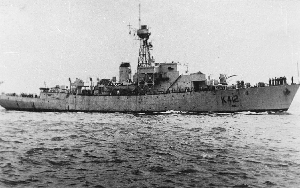
HMS Bamborough Castle was a Royal Navy Castle-class corvette. Bamborough Castle is in Northumberland, England, although it is now usually spelt "Bamburgh".
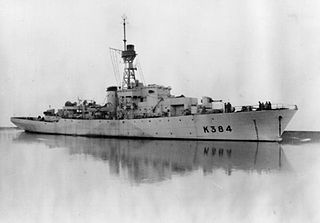
HMS Leeds Castle was a Castle-class corvette of the Royal Navy, originally with pennant number K384.

HMS Kenilworth Castle was a Castle-class corvette of the Royal Navy.
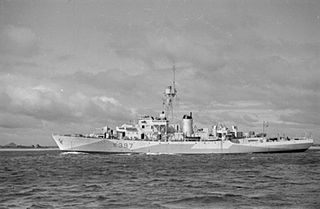
HMS Launceston Castle (K397) was a Castle-class corvette of the United Kingdom's Royal Navy, named after Launceston Castle in Cornwall. The ship was constructed during the Second World War and saw service primarily as a convoy escort.
HMS Portchester Castle was a Castle-class corvette built in 1943 and scrapped in 1958. She was the only ship of the Royal Navy to be named after Portchester Castle in Hampshire, and was used for the 1952 film The Cruel Sea, in which she played Saltash Castle.

The River class was a class of 151 frigates launched between 1941 and 1944 for use as anti-submarine convoy escorts in the North Atlantic. The majority served with the Royal Navy (RN) and Royal Canadian Navy (RCN), with some serving in the other Allied navies: the Royal Australian Navy (RAN), the Free French Navy (FFN), the Royal Netherlands Navy and, post-war, the South African Navy (SAN).
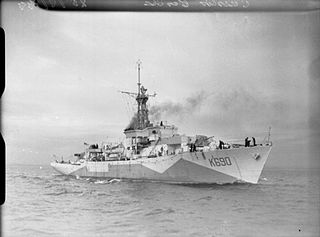
HMS Caister Castle was a Castle-class corvette of Britain's Royal Navy and was named after Caister Castle in Norfolk.
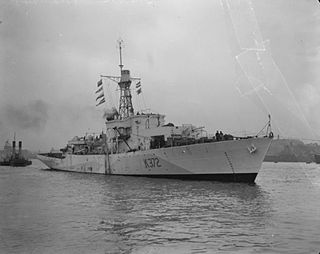
HMS Rushen Castle (K372) was a Castle-class corvette of the United Kingdom's Royal Navy. She was named after Castle Rushen in Castletown, Isle of Man.

HMS Hurst Castle (K416) was a Castle-class corvette of the United Kingdom's Royal Navy. She was named after Hurst Castle at the western end of the Solent in Southern England.

Empire Battleaxe was a British ship of the Second World War and as HMS Donovan in service with the Royal Navy just after the Second World War. Built as a Type C1-S-AY1 Landing Ship, Infantry named Cape Berkeley she then saw merchant service as Empire Battleaxe before being commissioned into the Royal Navy as HMS Empire Battleaxe and then Donovan. After she was decommissioned she returned to merchant service as Empire Battleaxe and was returned to the USA where she was renamed Cape Berkeley once again. A proposed sale in 1948 to China and renaming to Hai C fell through and she was scrapped in 1966.

Henry Robb, Limited, known colloquially as Robbs, was a Scottish shipbuilding company based at Leith Docks in Edinburgh. Robbs was notable for building small-to-medium sized vessels, particularly tugs and dredgers.
Six ships of the Royal Navy have been named HMS Colchester, after the town of Colchester:
HMS Falkland was a 50-gun fourth-rate ship of the line of the Royal Navy, built by Holland of New Castle, New Hampshire, and purchased by the navy in 1696.
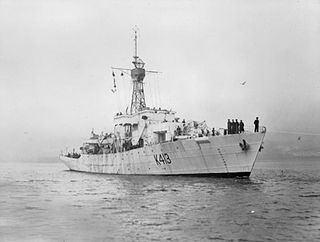
HMS Farnham Castle (K413) was a Castle-class corvette of Britain's Royal Navy.

HMS Hadleigh Castle (K355) was a Castle-class corvette of Britain's Royal Navy.

HMS Lancaster Castle was a Castle-class corvette of the Royal Navy. It served on convoy defence duties from 1944 to 1945, it was put in reserve in 1946 and eventually scrapped in 1960.
HMS Dumbarton Castle (K388) was a Castle-class corvette of the Royal Navy. She saw action in the Battle of the Atlantic in the Second World War.

HMS Berkeley was a Type I Hunt-class destroyer of the Royal Navy. She was a member of the first subgroup of the Hunt class and saw service in World War II before being bombed at Dieppe and then scuttled by HMS Albrighton.
James Joseph Colledge was a British naval historian, author of Ships of the Royal Navy, the standard work on the fighting ships of the British Royal Navy from the 15th century to the 20th century.

Ships of the Royal Navy is a naval history reference work by J. J. Colledge (1908–1997); it provides brief entries on all recorded ships in commission in the Royal Navy from the 15th century, giving location of constructions, date of launch, tonnage, specification and fate.

The International Standard Book Number (ISBN) is a numeric commercial book identifier which is intended to be unique. Publishers purchase ISBNs from an affiliate of the International ISBN Agency.





















